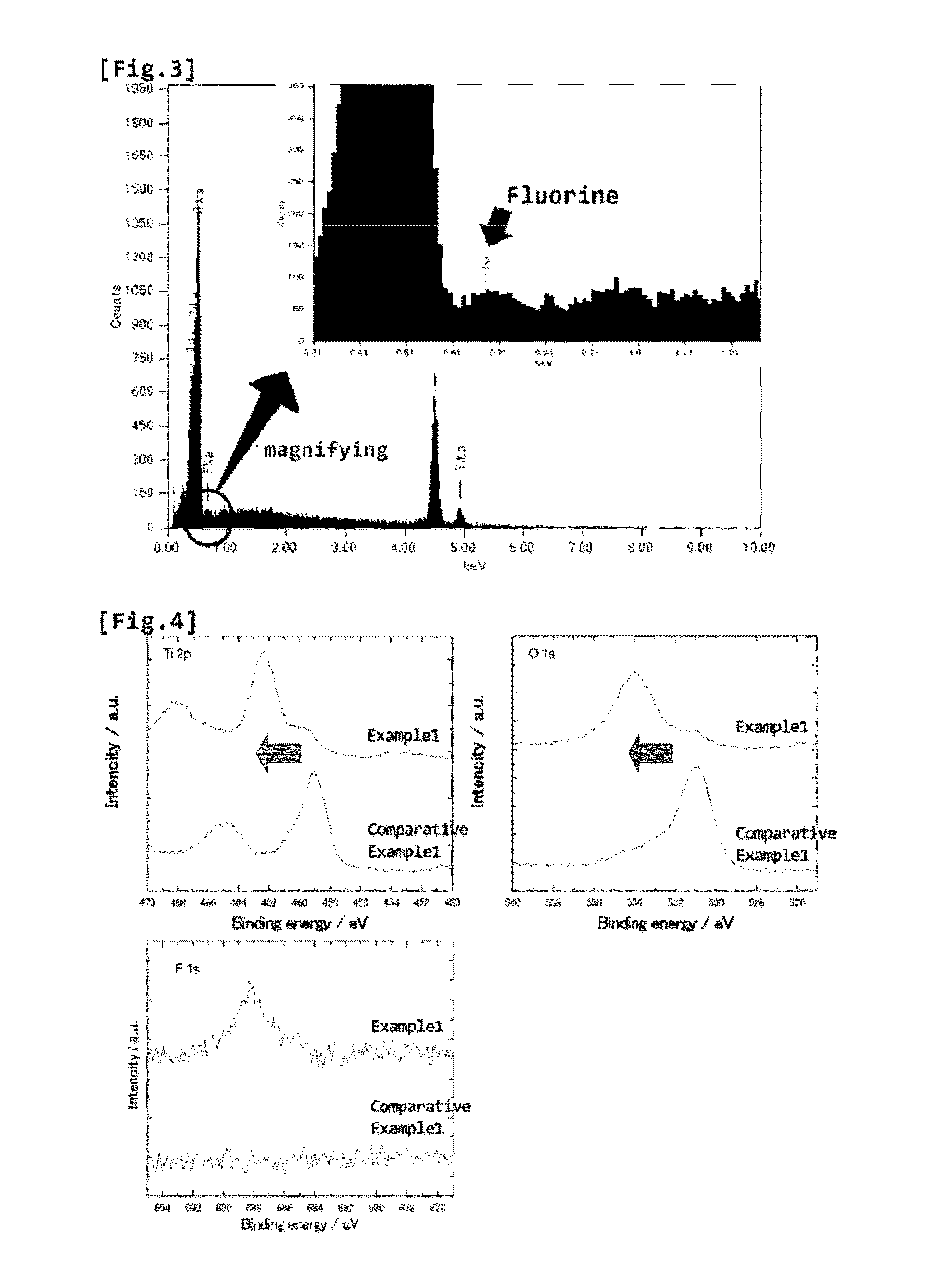Negative electrode material for lithium ion batteries containing surface-fluorinated b-type titanium oxide powder, method for producing same, and lithium ion battery using same
a technology of surface fluorinated titanium oxide and negative electrode material, which is applied in the direction of titanium dioxide, cell components, electrochemical generators, etc., can solve the problems of limited good effect of fluorination treatment, achieve high discharge capacity, high electrical potential negative electrode material, and improve discharge capacity
- Summary
- Abstract
- Description
- Claims
- Application Information
AI Technical Summary
Benefits of technology
Problems solved by technology
Method used
Image
Examples
example 1
Production of Fluorinated B-Type Titanium Oxide Powder
[0042]As starting materials, TiO2 anatase (available from Sigma-Aldrich Japan K.K., purity of 99% or more) and K2CO3 (available from Wako Pure Chemical Industries, Ltd., purity of 99.8%) were used. First, TiO2 anatase and K2CO3 were weighed so as to allow the mole ratio to be 4:1, and mixing was performed so that the raw materials as a sample were uniformly mixed for 1 hour at 400 rpm using a planetary ball mill. Subsequently, the sample was placed in an alumina crucible, and calcination was performed in two batches in the air at 1000° C. for 24 hours. Each of the resulting samples was immersed in 1 M HCl, and ion exchanging was performed for 72 hours at ordinary temperature. After ion exchanging, the sample was washed and filtered, and drying was performed for about 24 hours in a vacuum desiccator. After drying, dehydrating was performed by subjecting the sample to a heat treatment for 30 minutes at 500° C. to synthesize B-type ...
example 2
Analysis of Crystal Structure of Powder
[0045]With regard to the B-type titanium oxide powders obtained in Example 1 and Comparative Example 1, the bulk was analyzed for the crystal structure using the powder X-ray diffraction (XRD) method. As a powder X-ray diffractometer, Rint2500 (available from Rigaku Corporation) was used. As an X-ray source, CuKa was used, and the measurement was performed under the conditions of the tube voltage of 40 kV, the tube current of 200 mA, the measurement range of 5°≦2θ≦60°, the light receiving slit of 0.3 mm, the divergence slit of 1°, and the scattering slit of 1°.
[0046]As a result of the analysis, as shown in FIG. 1, with regard to Example 1 and Comparative Example 1, the change in the XRD peak shape and the shift in the peak are not observed, and it has been confirmed that the bulk structure of the B-type titanium oxide powder is not changed by the fluorination treatment.
example 3
Surface Shape Observation of Powder
[0047]With regard to the B-type titanium oxide powders obtained in Example 1 and Comparative Example 1, the surface shape observation was performed using a field emission type scanning electron microscope (FE-SEM). As an electron microscope, JSM7001FD available from JEOL Ltd. was used. The sample was subjected to sputtering of gold since the sample has low electron conductivity, after which the surface observation was performed at an acceleration voltage of 15 kV.
[0048]As a result of the observation, as shown in FIG. 2(a), in the observation at 5,000 magnifications, no significant change in the surface shape is observed between Example 1 and Comparative Example 1. Moreover, as shown in FIG. 2(b), in the observation at 30,000 magnifications, it has been confirmed that the surface of the sample powder of Example 1 is slightly smoothed compared to Comparative Example 1.
[0049]Moreover, with regard to the B-type titanium oxide powders obtained in Exampl...
PUM
 Login to View More
Login to View More Abstract
Description
Claims
Application Information
 Login to View More
Login to View More - R&D
- Intellectual Property
- Life Sciences
- Materials
- Tech Scout
- Unparalleled Data Quality
- Higher Quality Content
- 60% Fewer Hallucinations
Browse by: Latest US Patents, China's latest patents, Technical Efficacy Thesaurus, Application Domain, Technology Topic, Popular Technical Reports.
© 2025 PatSnap. All rights reserved.Legal|Privacy policy|Modern Slavery Act Transparency Statement|Sitemap|About US| Contact US: help@patsnap.com



